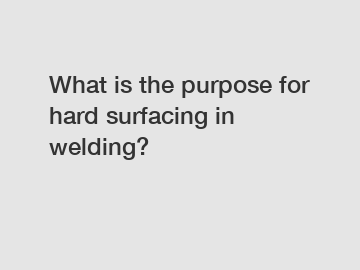What is the purpose for hard surfacing in welding?
If you work in the welding industry, you are likely familiar with the concept of hard surfacing. But for those who are not, hard surfacing is a process used in welding to apply a layer of tougher material onto a surface to improve its wear resistance and extend its lifespan. This process is commonly used in industries such as mining, construction, manufacturing, and agriculture where equipment is subjected to harsh conditions and constant wear and tear.
So, what is the purpose of hard surfacing in welding? Let's delve deeper into this question to understand the benefits and importance of this technique.
One of the primary reasons for hard surfacing is to protect the base metal from wear and abrasion. In industries where equipment is constantly exposed to friction, impact, and erosion, the surface of the metal can deteriorate over time. By applying a layer of hard material through welding, the base metal is shielded from these damaging forces, significantly extending its lifespan and reducing the need for frequent repairs or replacements.

Another key purpose of hard surfacing is to enhance the performance of the equipment. The tough outer layer created through hard surfacing can improve the resistance to heat, corrosion, and other environmental factors, making the equipment more durable and reliable. This can result in increased productivity, reduced downtime, and overall cost savings for businesses that rely on heavy machinery and equipment.
Furthermore, hard surfacing can also be used to restore worn-out or damaged components to their original dimensions and functionality. By carefully selecting the right type of hardfacing material and applying it with precision, welders can effectively rebuild and repair parts that have suffered from wear and tear, prolonging their service life and avoiding the need for expensive replacements.
In addition to protection and performance enhancement, hard surfacing can also improve the overall quality of the welded components. The hardfacing material can be chosen based on specific requirements such as hardness, toughness, and resistance to specific types of wear. This customization allows welders to tailor the properties of the welded surface to meet the exact needs of the application, resulting in a superior final product with optimized performance characteristics.
Moreover, hard surfacing can also be used to modify the properties of the base metal to better suit the intended application. For example, by applying a layer of hard material with superior wear resistance, the base metal can be transformed into a high-performance component capable of withstanding extreme conditions and heavy-duty use.
Overall, the purpose of hard surfacing in welding is multi-faceted and critical for ensuring the longevity, performance, and quality of equipment and machinery in various industries. Whether it is protecting against wear and abrasion, enhancing performance, restoring damaged components, improving quality, or modifying properties, hard surfacing plays a crucial role in extending the lifespan and maximizing the efficiency of welded components.
In conclusion, hard surfacing is a versatile and valuable technique in the welding industry that offers numerous benefits for businesses and industries that rely on heavy machinery and equipment. By understanding the purpose and significance of hard surfacing, welders can effectively utilize this technique to improve the durability, performance, and quality of welded components, ultimately leading to cost savings, increased productivity, and enhanced reliability.
For more plate wear, hot crack and cold crack in welding, excavator bucket hardfacinginformation, please contact us. We will provide professional answers.


